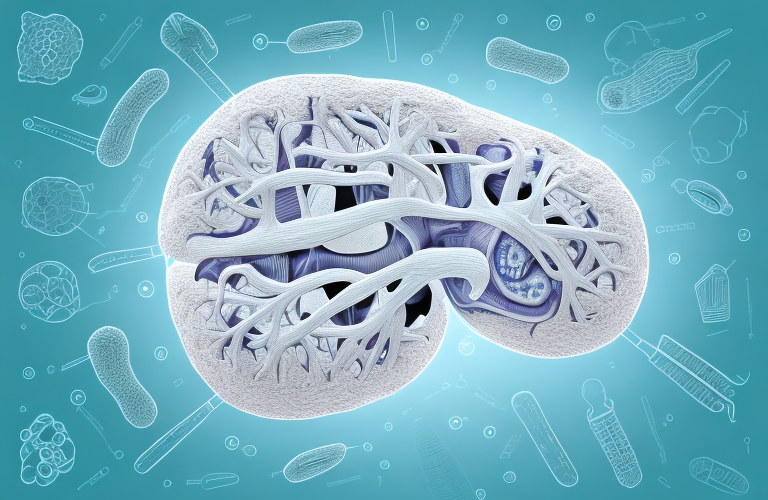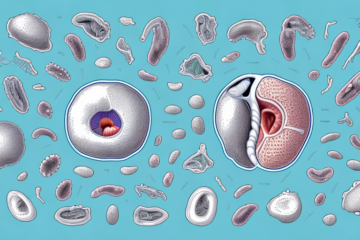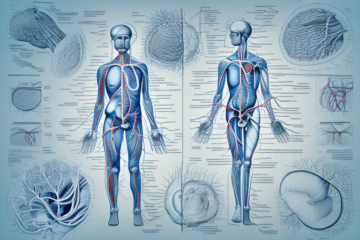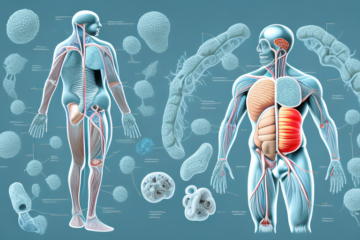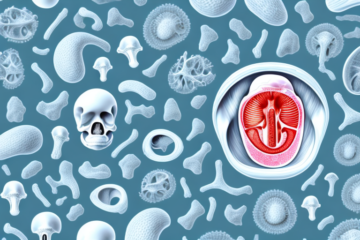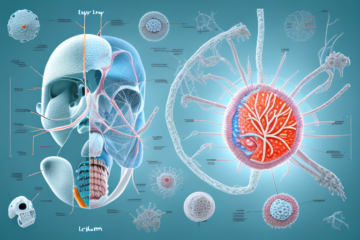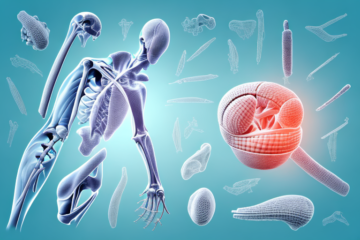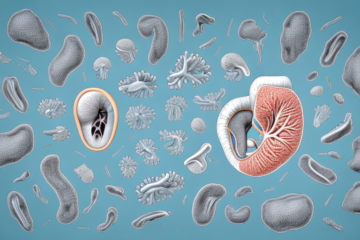The parathyroid glands are small, pea-sized structures located in the neck, usually behind the thyroid gland. There are typically four parathyroid glands, but some people may have more or fewer. These tiny glands play a vital role in maintaining calcium balance in the body, which is essential for numerous bodily functions, including muscle function, nerve function, and bone health.
The Role of Parathyroid Hormone in Maintaining Calcium Balance
The parathyroid glands produce a hormone called parathyroid hormone (PTH), which helps regulate the level of calcium in the blood. PTH accomplishes this by stimulating the release of calcium from bone tissue, increasing the absorption of calcium from the intestines, and decreasing the amount of calcium lost in urine.
If calcium levels in the blood become too low, the parathyroid glands release more PTH to increase calcium levels. If calcium levels become too high, the gland reduces PTH production to preserve calcium in the bones.
Parathyroid hormone also plays a role in vitamin D metabolism. PTH stimulates the production of an active form of vitamin D, which helps the body absorb calcium from the intestines. Without enough vitamin D, the body cannot absorb enough calcium, leading to weakened bones and other health problems.
How Many Parathyroid Glands Do Humans Have?
As mentioned earlier, humans typically have four parathyroid glands; two on each side of the neck. However, some people may have more or fewer glands, which can increase the risk of developing parathyroid disorders.
The parathyroid glands are responsible for producing parathyroid hormone (PTH), which helps regulate calcium levels in the body. When calcium levels are too low, PTH is released to stimulate the release of calcium from bones and increase absorption of calcium from the intestines. When calcium levels are too high, PTH production is decreased to prevent excess calcium from being absorbed.
Parathyroid disorders can occur when the glands produce too much or too little PTH. Hyperparathyroidism, a condition where the glands produce too much PTH, can lead to weakened bones, kidney stones, and other health problems. Hypoparathyroidism, a condition where the glands produce too little PTH, can cause muscle cramps, seizures, and other symptoms related to low calcium levels.
The Location and Size of the Parathyroid Glands
The parathyroid glands are located behind the thyroid gland, near the Adam’s apple. Although small, they play a critical role in maintaining the level of calcium in the body, which is essential for proper functioning of the nerves, muscles, and bones.
Each person typically has four parathyroid glands, two on each side of the thyroid gland. They are usually about the size of a grain of rice, but can vary in size and shape. In some cases, a person may have an additional parathyroid gland or one or more of the glands may be located in a different area of the neck or chest. It is important for these glands to function properly, as an overactive or underactive parathyroid gland can lead to health problems such as osteoporosis, kidney stones, and muscle weakness.
What are the Symptoms of Parathyroid Dysfunction?
Parathyroid disorders can lead to an imbalance of calcium levels in the blood, which can cause various symptoms such as: muscle weakness, fatigue, excessive thirst, frequent urination, bone pain, depression, and memory problems.
In addition to the aforementioned symptoms, parathyroid dysfunction can also cause gastrointestinal issues such as constipation, nausea, and vomiting. Patients may also experience kidney stones, due to the excess calcium in their urine.
It is important to note that some patients with parathyroid dysfunction may not experience any symptoms at all, making it difficult to diagnose the condition without routine blood tests.
Hyperparathyroidism: Causes, Symptoms, and Treatment Options
Hyperparathyroidism occurs when the parathyroid glands produce an excessive amount of PTH hormone, leading to high levels of calcium in the blood. This can lead to significant health problems such as osteoporosis, kidney stones, and digestive issues.
Treatment for hyperparathyroidism usually involves surgery to remove any enlarged or overactive glands. The surgery is typically straightforward and has a high success rate in curing the condition.
It is important to note that hyperparathyroidism can be caused by a variety of factors, including genetics, radiation exposure, and certain medications. Additionally, some individuals may not experience any symptoms of the condition, making it important to regularly monitor calcium levels through blood tests.
Hypoparathyroidism: Causes, Symptoms, and Treatment Options
Hypoparathyroidism is a rare condition where the parathyroid glands do not produce enough PTH, leading to low calcium levels in the blood. This can cause muscle cramps, tingling, and numbness in the hands and feet, and muscle spasms.
Treatment for hypoparathyroidism typically involves calcium and vitamin D supplements, along with regular blood tests to monitor calcium levels in the blood.
In some cases, surgery may be necessary to remove the damaged or malfunctioning parathyroid gland. This is usually only recommended if other treatments have not been effective in managing the symptoms of hypoparathyroidism. It is important for individuals with hypoparathyroidism to work closely with their healthcare provider to develop a treatment plan that is tailored to their specific needs and symptoms.
The Link Between Vitamin D and Parathyroid Function
Vitamin D is an important nutrient that plays a vital role in calcium absorption and metabolism. Without sufficient vitamin D, the body cannot absorb calcium efficiently, which can lead to parathyroid disorders. A lack of vitamin D can also contribute to weak bones, and other health problems.
Recent studies have also shown that vitamin D deficiency may be linked to an increased risk of certain cancers, such as breast, colon, and prostate cancer. This is because vitamin D helps regulate cell growth and division, and a lack of it can lead to abnormal cell growth. It is important to maintain adequate levels of vitamin D through a balanced diet and exposure to sunlight, or through supplements if necessary.
The Importance of Regular Parathyroid Testing for Overall Health
Regular parathyroid testing is essential for overall health and wellbeing. Calcium imbalances can cause significant health problems and knowing the levels of calcium in the blood can help detect any underlying parathyroid conditions early enough to prevent damage to the body.
Parathyroid conditions can be difficult to detect without regular testing, as symptoms may not be noticeable until the condition has progressed. Some common symptoms of parathyroid conditions include fatigue, weakness, bone pain, and frequent urination. However, these symptoms can also be attributed to other health issues, making regular testing even more important.
Surgical Procedures for Parathyroid Disorders: Risks and Benefits
The most common surgical procedure used to treat parathyroid disorders such as hyperparathyroidism involves the removal of the affected gland(s). This surgery is usually performed under general anesthesia and is highly effective in curing the condition.
Like all surgical procedures, there are risks associated with parathyroid surgery, including bleeding, infection, and damage to nearby structures in the neck. However, the risks are minimal, and the benefits of correcting the parathyroid disorder usually outweigh the risks.
Another surgical procedure used to treat parathyroid disorders is called minimally invasive parathyroidectomy. This procedure involves making a small incision in the neck and using a special camera to locate and remove the affected gland(s). This procedure is less invasive than traditional surgery and has a shorter recovery time.
In some cases, medication may be used to treat parathyroid disorders instead of surgery. However, medication is usually only effective in managing the symptoms of the condition and does not cure it. Surgery remains the most effective treatment for parathyroid disorders.
Alternative Treatments for Parathyroid Disorders: Do They Work?
Alternative treatments such as acupuncture, herbal medicine, and dietary supplements claim to help treat parathyroid disorders. However, there is little scientific evidence to support their effectiveness. It is always advisable to consult a qualified medical professional before trying any alternative treatments for parathyroid disorders.
Some people may turn to alternative treatments for parathyroid disorders because they are dissatisfied with traditional medical treatments or are seeking a more natural approach. However, it is important to note that alternative treatments may not be regulated by the FDA and could potentially interact with other medications or cause harmful side effects. It is crucial to discuss any alternative treatments with a healthcare provider before trying them.
How to Maintain Healthy Parathyroid Function through Lifestyle Choices
Maintaining healthy parathyroid function involves adopting healthy lifestyle habits such as eating a balanced diet that is rich in calcium, vitamin D, and other essential nutrients. Regular exercise can also help improve the strength of bones and muscles.
Avoiding smoking, limiting alcohol consumption, and reducing stress levels can also help prevent damage to the parathyroid glands and maintain healthy calcium levels in the body.
In addition to these lifestyle choices, it is important to regularly monitor your parathyroid function through blood tests and check-ups with your healthcare provider. If you experience symptoms such as fatigue, weakness, or bone pain, it is important to seek medical attention as these may be signs of parathyroid dysfunction.
The Future of Parathyroid Research and Treatment Options
Research into parathyroid disorders is continuously evolving, and new treatment options are continually being explored. This research is essential in identifying new ways to prevent and treat parathyroid disorders, potentially leading to better, more effective treatments in the future.
Overall, the parathyroid glands play a vital in maintaining calcium balance in the body. Understanding their function and the various disorders that can affect them is crucial for maintaining good health and overall wellbeing.
One area of research that shows promise is the use of targeted therapies for parathyroid disorders. These therapies aim to specifically target the overactive parathyroid gland, while leaving the healthy glands intact. This approach could potentially lead to fewer side effects and better outcomes for patients.
Another area of research is focused on developing non-invasive diagnostic tools for parathyroid disorders. Currently, the most common method for diagnosing these disorders is through invasive procedures such as a parathyroidectomy. However, non-invasive methods such as imaging and blood tests are being explored as potential alternatives.

